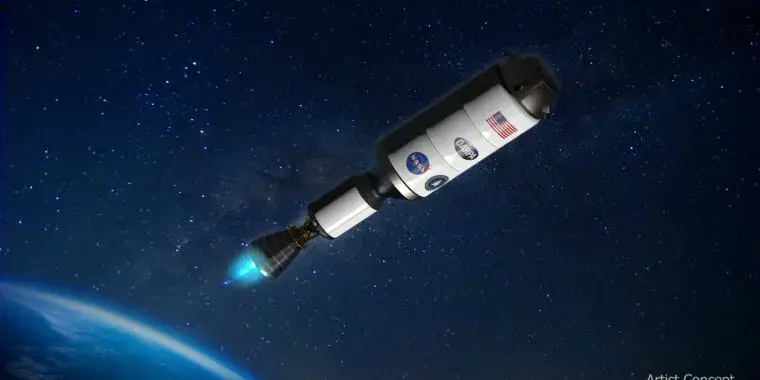
They had a nuclear rocket engine developed and ready to go back in the sixties. Better late than never, I guess.

The basic idea is straightforward: A nuclear reactor rapidly heats up a propellant, probably liquid hydrogen, and then this gas expands and is passed out a nozzle, creating thrust. But engineering all of this for in-space propulsion is challenging, and then there is the regulatory difficulty of building a nuclear reactor and safely launching it into space.
Hmm it seems like we are still relying on a propellant of some kind.

I mean, you kinda have to unless you’re pushing off/getting pushed by some other object like a planet or star (via electromagnetic cables or gravity assists for instance). Cant just generate momentum from nowhere.

Yeah that makes perfect sense. It is just kind of interesting to think you basically have unlimited power from the reactor but you still in fuel to move in space.

It is theoretically possible to use the nuclear fuel itself as the propellant too in various ways, and they can in theory be quite efficient if more difficult to implement (because making your propellant go faster makes for more efficiency, for a rocket making the propellant hotter makes it faster, and using a substance to cool the reactor and then using that substance as propellant dilutes the resulting heat more than what you would get from the fuel directly. Usually higher efficiency in this manner means less thrust though). For example, there is a concept called a fission fragment rocket where the individual microscopic particles of fuel that react break off when they do so, and then are channeled together into an exhaust beam. Or in a less elegant and more sheer brute force approach, there is a concept (probably one that won’t ever get really built I imagine) wherein you don’t bother with a normal rocket nozzle or anything and instead put a strong and thick plate behind your ship, attached by a set of very heavy duty shock absorbers, and then continually detonate a sequence of nuclear bombs behind it to push the ship along.

Personally I’m a big fan of the nuclear salt water rocket, because nothing says exhaust velocity like a continuous Chernobyl accident out the back of a rocket nozzle.

There’s an ion engine that does just that. Unfortunately thrust is very low.

Ion engines still use propellant, they dont just create momentum. Your link even mentions as much, pointing out that they use inert gases as their propellant. They merely use a lot less propellant than chemical rockets by accelerating that propellant to higher speeds.

I mean, you will always need a propellant, E=MC^2 after all, even if you’re Pushing with light, you’re still losing mass as you expel that out the back, no matter how you cut it.
The real question is how much work you’re getting out of each unit of mass you toss out they back, and that depends on how fast you toss it. These kinds of engines (nuclear thermal engines) get about expel their reaction mass at about 8000 meters per second, the most efficient conventional engine pushes exhaust out at about 4500 meters per second. So, you’re getting a. It less than twice as much change in the crafts speed per unit of mass used for these kinds of engines.
That may not seem like a game changer, but a 50% increase in efficiency rapidly compounds since most of the mass you’re trying to move with propellant is… well other propellant.

I imagine the engine has to weigh a lot more though? So only really suited to huge or deep space missions where also having a nuclear reactor is incredibly useful

Oh yah, much heavier, and lower max thrust to, but the whole package is still much lighter considering the huge fuel savings which are most of the mass of the vehicle anyways.
Generally they are mainly intended for longer range missions or where a lot of big maneuvers need to be made. So something that needs to ferry cargo to the moon and back would be an excellent use case.

Yeah, how much thrust would you get per kilo of liquid nitrogen? What sort of top speed? Sounds like it would take a decent amount I imagine.

This probably depends on how rapidly you can make the propellant material expand (more force) and how big you can build the expansion chamber/nozzle (more volume).
Practical space propulsion is pretty much just throwing shit out the back of your vehicle as fast as possible.

These kinds of engines get about double the exhaust velocity of high efficiency conventional rockets. (A hydrolox engine like that used on the space shuttle or the centaur upper stage getting an exhaust velocity of about 4500 m/s and a nuclear thermal getting about 8000m/s)

